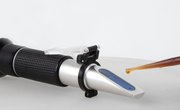Calibration curves are used to determine the concentration of unknown substances based on previous measurements of solutions of known concentrations. The precision and accuracy of the measurements are dependent on the calibration curve. The better the curve the more accurate the answer, the worse the curve the worse the accuracy. This is a type of comparison method, the unknown is compared to a known. Calibration curves are used for all types of measurements using many different machines. This example uses a spectrophotometer.
- Spectrophotometer
- Standard solution
- Graphing program
Dilute the standard solution to different concentrations. It is typical to do a 10 times dilution, 20 times dilution, 30 times dilution or some other step wise solution. Do each dilution twice so that all samples are in duplicate.
Calculate the concentrations of the diluted solutions. An example of the new concentration for the 10 times dilution would be the the concentration of the first solution multiplied by 0.10.
Read the absorbency of the diluted solutions on the spectrophotometer. Insert a cuvette into the spectrophotometer so that the triangle marking is lined up with the light path. Close the lid of the spectrophotometer and press the zero button. Zero the machine with distilled water every five samples. Once the machine is zeroed read the samples in the same way. The one difference is you press enter to get the absorbency. Press enter after closing the lid. Record these values in a notebook.
Graph the absorbency versus the calculated known concentrations for all samples. The known concentration will be on the X axis and the absorbency on the Y axis. It is best to create the graph in a computer graphing program.
Use the graphing program to calculate the regression line for the graphed points. It is possible to delete one of the two points for each dilution to get the best regression line. This is the point of doing each dilution in duplicate. The closer the R^2 value is to one, the better the regression line. Make note of the regression line equation.
Read the absorbency of the unknown concentration solution on the spectrophotometer. Record this absorbency.
Calculate the concentration of the unknown solution using the regression line equation. The unknown absorbency is substituted as Y in the equation. You are solving the equation for X, the concentration.
Things You'll Need
References
About the Author
Liz Tomas began writing professionally in 2004. Her work has appeared in the "American Journal of Enology and Viticulture," "BMC Genomics" and "PLoS Biology." She holds a Master of Science in food science from Cornell University and a Bachelor of Science in biochemistry from the University of New Hampshire. She is pursuing her Ph.D. in oenology at Lincoln University.
